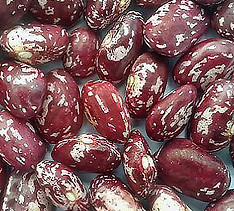African Bean Consortium (ABC)

Kenyan common bean landraces. Photo credit: Shamir Misango.
Common bean (Phaseolus vulgaris) is the most important legume crop, grown on nearly 8 million ha in Africa where it is consumed and traded by more than 100 million people. The annual per capita consumption in Rwanda, Kenya and Uganda (50-60 kg) is the highest in the world.
Beans are well suited to smallholder agriculture and low-input production systems. Like other legumes, they establish a mutually beneficial relationship with Rhizobium soil bacteria that leads to the conversion of Nitrogen from the air into a form that can be used by plants, improving soil fertility and structure. Beans mature fast, are very nutritious and a source of protein, essential minerals and dietary fibres. Their sale is an important source of income.
The African Bean Consortium (ABC) was established in 2006 under the scientific leadership of Professor Paul Gepts of the University of California, Davis, USA. In June 2022 Dr Travis Parker took over as the scientific leader of the ABC following the retirement of Professor Gepts.

The African Bean Consortium 2019 Annual Meeting group photo.
ABC OBJECTIVES
1. To develop multiple disease-resistant common bean varieties using marker assisted selection
The production of beans in Africa faces a number of constraints, among which is susceptibility to diseases.
ABC projects aim to combine resistance in popular bean varieties to some of the most important diseases: anthracnose, angular leaf spot, common bacterial blight, Pythium root rot, bean common mosaic virus and bean common necrotic mosaic virus. More recently, bean scab and rust have joined the list of target diseases.

i

ii

iii

iv
Symptoms of anthracnose (ANT, caused by a fungus, Colletotrichum lindemuthianum) symptoms include the development of black spots on pods (i); and a change of colour (to red and then black) of the veins of infected leaves (ii). Symptoms of angular leaf spot (ALS; another fungal disease caused by races of Psuedocercospora griseola) in pods (iii); and leaves of common bean (iv).
i

v

vi

vii

viii
The leaves plants infected by common bacterial blight (CBB; causative agent Xanthomonas campestris) infected plants display small water-soaked spots on the underside of leaves which expand and turn brown in the middle; the lesions are bordered by a lemon yellow ring (v). Pythium root rot (PRR) infection results in wet rot of roots and sometimes stems (arrow in vi). Bean Common Mosaic Virus (BCMV) symptoms on leaves (vii); and whole plants (viii).
v

ix

x

xi

xii
Bean scab on pods (ix); and leaves (x); of common bean. Symptoms of bean rust (a fungal disease casused by Uromyces appendiculatus) on leaves of infected plants: rust-coloured spots within yellowed areas (xi); and leaves infected by both rust and ALS (xii).
2. To understand, preserve and use the diversity of beans in Africa
Common bean was independently domesticated initially in Mesoamerica and later in the Andes (1). This dual origin is reflected in the composition of the two main gene pools - the Mesoamerican germplasm is the more diverse, and Andean varieties typically have larger seeds. While there is a degree of reproductive isolation between the two gene pools, hybrid types have been generated with some success.
Most, but not all, African germplasm is of the Andean type. The existence of the two major gene pools is important agronomically because a number of pathogens, including those responsible for angular leaf spot and anthracnose, have co-evolved with their respective host gene pool. Andean varieties tend, for example, to be more susceptible to Andean strains of the pathogens, while Mesoamerican varieties are often resistant to these strains (and vice versa). Thus, gaining an understanding of the genetic diversity of not just the host, but also of the pathogen populations present within a given environment, is important for the breeder. KT has supported a number of research projects of this nature, typically undertaken by MSc or PhD students.
1. Gepts P., 1988, A Middle American and an Andean common bean gene pool, Kluwer Academic Publishers: Dordrecht, The Netherlands, pp.375-390. https://doi.org/10.1007/978-94-009-2786-5_15




Beans are a very diverse crop, displaying extensive variation with respect to seed size, colour, texture and taste, as well as to growth habit and plant morphology.
3. To develop scientific expertise, versatility and autonomy in breeding methodologies, including the use of molecular markers for selection
The Kirkhouse Trust (KT) ABC programme has to date awarded scholarships supporting 27 MSc and 13 PhD students. Dr Esther Arunga and Dr Yayis Rezene, now ABC PIs at Embu University, Kenya, and the Southern Agricultural Research Institute (SARI), Ethiopia, respectively, are former KT PhD Scholars.

i

ii

iii
Dr Esther Arunga in 2010, a MSc student at the time, making crosses in the greenhouse (i); Dr Arunga in a pathology course organised by CIAT in 2011 (ii); Dr Arunga with her research team in 2021, University of Embu, Kenya (left to right: Mr Brian Weseka Wafula; Dr Arunga; Ms Serah Njau; Ms Nancy Munubi; and Ms Grace Wamwui Watare; iii).
Dr Parker's laboratory at the University of California, Davis hosts ABC students for training, and training is also a component of the annual ABC meetings, and ad hoc training programmes have also been held.

i

ii

iii
Bean pathology training organised by CIAT in 2016. Participants: Bethel Mulugeta, Shamir Misango, Mihiret Tadesse, Antony Kimani, Jeanine Omfuyisoni, and Yona Masheti (i & ii). Participants to the 2018 ABC Annual Meeting identifying a bean disease (iii).

Dr Claire Mukankusi
Dr Clare Mukankusi from the International Center for Tropical Agriculture (CIAT), whom KT is grateful for her long-term support and advice, and for her regular attendance at the ABC Annual Meetings (including the online editions!).

